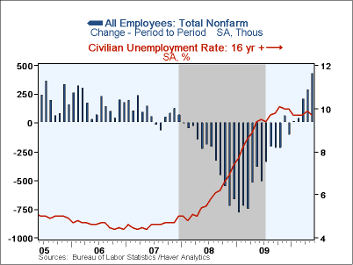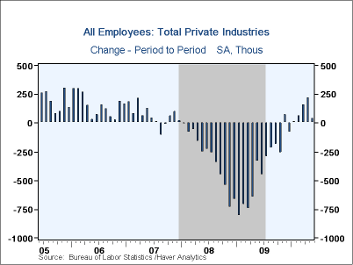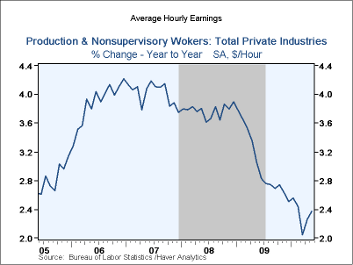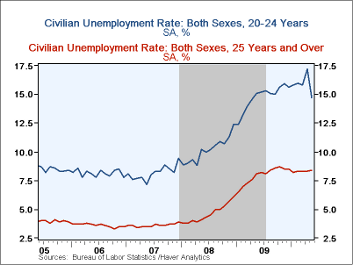 Global| Jun 04 2010
Global| Jun 04 2010U.S. Payroll Gain Is Propelled by 2010 Census Hiring, But Private-Sector Hiring Remains Soft
by:Tom Moeller
|in:Economy in Brief
Summary
On the surface, the 431,000 gain in May payrolls after an unrevised 290,000 April rise looks strong but, in fact, it was not. First, the increase was raised by the one-time hiring of 411,000 Census workers. Second, the gain actually [...]
On the surface, the 431,000 gain in May payrolls after an unrevised 290,000 April rise looks strong but, in fact, it was not. First, the increase was raised by the one-time hiring of 411,000 Census workers. Second, the gain actually fell short of Consensus expectations for a 508,000 rise in the total. Lastly, the 41,000 gain in private sector payrolls was the weakest since January.
The shortfall in private sector was broad-based.
Construction sector hiring fell 35,000 and reversed the increases in
the prior two months. Private service-sector hiring rose just 37,000
following firmer gains during five of the prior six months. The
weakness reflected a 6,600 decline (-0.8% y/y) in retail sector hiring,
a 12,000 shortfall (-2.2% y/y) in financial sector employment and a
soft 2,000 increase (-0.3% y/y) in leisure & hospitality
jobs.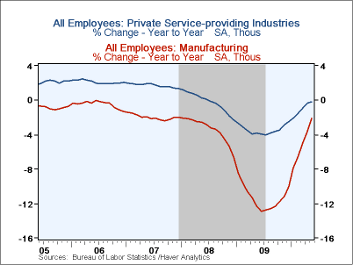
There were some bright spots in the hiring figures. The 29,000 rise in factory payrolls was the fifth in a row. Health care jobs rose 13,100 (1.9% y/y) though that was the weakest increase since April of last year. Finally, temporary jobs rose 31,000, on a par with the prior three months' increases but off from the earlier gains. Perhaps also salvaging the sense of disappointment in the overall payroll employment figures was the one-month diffusion index. The 54.1 figure showed that hiring was positive in more industries than not. Yet another caveat is that this was the lowest figure since January.
Also countering some sense of labor-market softness was a decline in the civilian unemployment rate to 9.7%, although that just reversed the April increase. Moreover, the decline was all due to a 322,000 shrinkage (-0.4% y/y) in the labor force, the first drop since December. Household sector employment, in fact, also declined 35,000 (-0.7% y/y) which was the first drop this year. Of note should be that the unemployment rate for ages 20-24 fell sharply to 14.7% from 17.2%. The rate for those 25 and over rose to 8.4%, its highest this year, due to expansion in the labor force. The number of employed rose a respectable 129,000 (3.8% y/y). Finally, the broadest measure of unemployment which adds marginally attached workers and those working part-time for economic reasons to the unemployed slipped to 16.6% from the 4Q '09 high of 17.3%.
Back to the establishment survey, the gain in the length of the average workweek to 34.2 hours also was encouraging. It raised the average 2Q index of aggregate hours worked (employment times hours) by 3.7% (AR) from 1Q after that quarter's 2.3% increase. That could suggest faster real GDP growth versus 3.0% in 1Q. Finally, average hourly earnings rose 0.2% and that lifted the y/y increase to 2.4% from its 2.1% low in March.
The figures referenced above are available in Haver's USECON database. Additional detail can be found in the LABOR and in the EMPL databases.
Subsidizing Job Creation in the Great Recession from the Federal Reserve Bank of New York is available here.
| Employment: 000s | May | April | March | Y/Y | 2009 | 2008 | 2007 |
|---|---|---|---|---|---|---|---|
| Payroll Employment | 431 | 290 | 208 | -0.4% | -4.3% | -0.6% | 1.1% |
| Previous | -- | 290 | 230 | -- | -- | -- | -- |
| Manufacturing | 49 | 40 | 19 | -2.1% | -11.3% | -3.4% | -2.0% |
| Construction | -35 | 14 | 27 | -8.6% | -15.7% | -6.1% | -0.8% |
| Private Service Producing | 37 | 156 | 101 | -0.2% | -3.4% | -0.2% | 1.7% |
| Government | 390 | 72 | 50 | -1.5% | 0.2% | 1.3% | 1.1% |
| Average Weekly Hours | 34.2 | 34.1 | 34.0 | 33.9 (May '09) | 33.1 | 33.6 | 33.8 |
| Average Hourly Earnings | 0.3% | 0.1% | 0.0% | 1.9% | 2.7% | 3.1% | 3.2% |
| Unemployment Rate | 9.7% | 9.9% | 9.7% | 9.4%(May '09) | 9.3% | 5.8% | 4.6% |
Tom Moeller
AuthorMore in Author Profile »Prior to joining Haver Analytics in 2000, Mr. Moeller worked as the Economist at Chancellor Capital Management from 1985 to 1999. There, he developed comprehensive economic forecasts and interpreted economic data for equity and fixed income portfolio managers. Also at Chancellor, Mr. Moeller worked as an equity analyst and was responsible for researching and rating companies in the economically sensitive automobile and housing industries for investment in Chancellor’s equity portfolio. Prior to joining Chancellor, Mr. Moeller was an Economist at Citibank from 1979 to 1984. He also analyzed pricing behavior in the metals industry for the Council on Wage and Price Stability in Washington, D.C. In 1999, Mr. Moeller received the award for most accurate forecast from the Forecasters' Club of New York. From 1990 to 1992 he was President of the New York Association for Business Economists. Mr. Moeller earned an M.B.A. in Finance from Fordham University, where he graduated in 1987. He holds a Bachelor of Arts in Economics from George Washington University.


